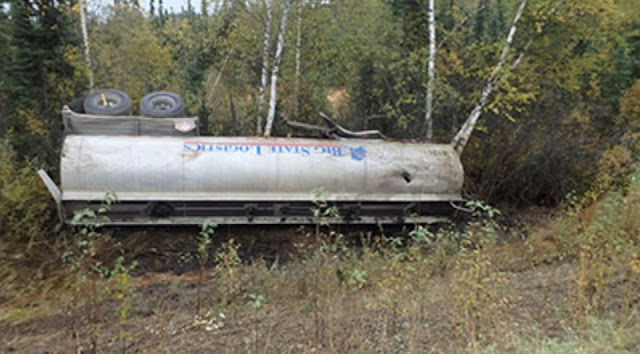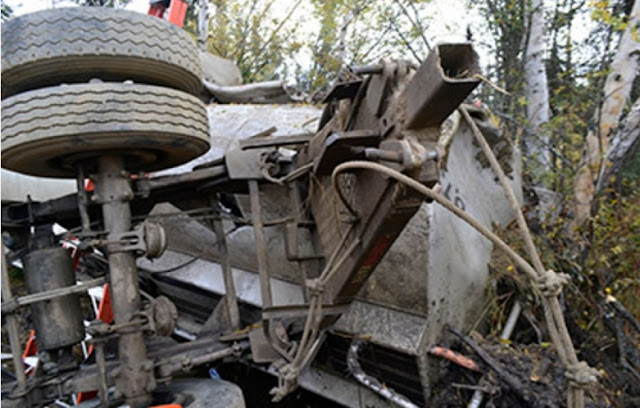Richardson Highway tank spill totals more than 3,500 gallons
Source: http://www.ktoo.org, September 7, 2016
By: Tim Ellis
Cleanup work continues today near Birch Lake where a tractor-trailer tank loaded with 5,000 gallons of diesel fuel overturned Monday, spilling the fuel into a ditch that runs between a small wetland and the Richardson Highway.
The workers are trying to keep fuel from seeping into the wetland or the lake.
Alaska state environmental officials say a fuel spill from an overturned fuel tank off the Richardson Highway totaled more than 3,500 gallons, the Associated Press reported.
The Department of Environmental Conservation said Wednesday the cleanup continues at mile 306 of the highway, where the accident involving the Big State Logistics tank occurred Monday afternoon.
Alaska Department of Environmental Conservation on-site coordinator Tom DeRuyter said workers Tuesday suctioned just more than 11,000 gallons of fuel-and-water mix from a ditch just south of the roadside pulloff to the Birch Lake State Recreation Site.
They also plugged some culverts that runs under that stretch of the Richardson Highway to prevent contaminated water from flowing in to Birch Lake, DeRuyter said.
“No oil has been seen on the lake,” he said Tuesday afternoon. “Is there oil infiltrating underneath the roadway? I suspect there is.”
Workers pushed up dirt berms to limit fuel from flowing into the wetland. He says the marshy area sits a bit higher than the lake, so he thinks the fuel is more likely to flow downgradient in the other direction.
“It all goes toward the lake,” he said, “and that’s why the culverts are plugged and … we’re watching those to make sure no oil gets into the culvert system.”
Tests will be conducted to determine whether diesel leaked into the wetland or lake. DeRuyter said the first priority is removing fuel and contaminated soil, which is why workers began building a roadway Tuesday to enable equipment to get in to the area to begin excavating.
“We still have pure fuel that’s leaking out of the vegetative mat and is forming pools on-site,” he said. “We need to get rid of that and the heavily contaminated soil and the vegetation that’s hold the oil and allowing it to leak out slowly. And that’s really the first step in this process.”
DEC and Alaska State Troopers both are investigating the spill and the equipment failure that apparently led to it.
Troopers say there were no injuries.
DEC says it hasn’t received any reports of wildlife being affected by the fuel.
A Trooper spokesperson couldn’t yet provide specifics, but said it appears the driver was not speeding.
Photos taken by DEC show what appeared to be jagged edges around the tip of the tongue that connected the rear tank to the tanker truck – which was carrying another 9,000 gallons of diesel.
Troopers said the Big State Logistics tanker was just rounding the bend of the long curve along the southern shore of Birch Lake about 1 p.m. Monday when somehow the trailer in tow broke loose, hit the ditch and overturned.
ADEC said the tank had multiple punctures and that most if not all of the 5,000 gallons of diesel in the tank quickly leaked out.
Mark Lockwood says he saw the tanker approach as he was sitting in his truck at the intersection of Lost Lake Road, waiting to get onto the highway and get back to Fairbanks.
“The fuel truck got past me,” he said, “I looked again, nobody was coming, pulled out. And the fuel truck was pulling over to the side of the road – sans trailer, and a hitch dangling. And so I just missed seeing that happen.”
A DEC news release says crews and equipment will be working around the cleanup site today, and that flaggers will be controlling traffic along that stretch of the highway around milepost 306.
=========
Responders Clean Up Diesel Spill at Richardson Highway Tanker Rollover
Alaska Native News Sep 7, 2016.
Roadside pond impacted by diesel, September 5, 2016 (Photo/John Ebel – ADEC)
Damaged tanker being removed from site, September 5, 2016 (Photo/John Ebel – ADEC)
•••••••
(Hover over image to pause slideshow)
Although the secondary tank carrying #11 Ultra-Low Sulfer diesel that rolled over in a ditch at mile 306 of the Richardson Highway on Labor Day has been pumped out and the tanker pulled out and removed from the scene, the Alaska Department of Environmental Conservation did not reveal the actual amount of diesel spilled in the incident on Tuesday.
According to the trooper report on the incident, at 1:04 pm on Monday, as a 2012 Freightliner pulling double fuel tanks, driven by 63-year-old Edwin Case, suffered an equipment failure when the rear trailer tongue failed and the rear trailer detached and rolled in the southbound ditch.
The rear tank, carrying an estimated 5,000-5,500 gallons of diesel, was punctured in multiple places when it impacted.
State TTroopers and Big State Logistics, along with Salcha Fire and Rescue responded to the scene. They were joined by the Fairbanks North Star Borough Hazmat Team and a representative of the Alaska Department of Transportation Commercial Fehicle Enforcement and cleanup and preventative efforts began.
ADEC stated in an incident report that “Crews successfully blocked culverts north of the spill site that lead into Birch Lake utilizing tarps and soil.” They report that this measure kept any fuel from entering the lake.
Additional berms were established to prevent further migration of fuel, and crews began removing fuel from the tank while troopers provided traffic control.
By 3:30 pm, flaggers and flagger equipment arrived and took over traffic control from the troopers.
The Alaska Department of Environmental Conservation arrived on the scene as the pumping operation was still underway. Two hours after that, the tanker was succeswsfully uprighted and towed to the highway.
A trailer was utilized to take the damaged tank from the scene.
Two vac trucks were soon on scene to begin removal of the oil and contaminated water. ADEC reports that “A total of 11,020 gallons of oil and water mixture were transported to an above-ground storage tank at Organic Incineration Technology, Inc.” There were no injuries in the incident, and the remaining fuel tank, with its 9,000 gallons of fuel, was not impacted.
===========
| Top level safety classification | |
| Annually inspected tankers | |
| Trained employees |
|
Big State tanker at the shop, on the way to a customer |
|
| Safety is a priority for usWe
understand our responsibility to safely transport petroleum and other
bulk products in Alaska. We are committed to the safety of
others on the roads, our personnel, and Alaska's environment. We
have transported hundreds of millions of gallons of fuel with minimal losses. The US Department of Transportation rates our safety record "satisfactory." This is the top level of the safety classifications for transporters. You can see information about our safety record on the web. Spill response Big State employees have HAZWOPER training in spill response in the unlikely event we spill some product. Our response van (photo at right) has responded to a number of spills called in by other companies and government agencies. We are pleased to continue to help others with this service. Annual inspections Federal regulations require annual inspections of tankers. We carefully comply with these regulations for the safety of all and to prevent spills. Trained employees We train all of our drivers in safe procedures for transporting and handling hazardous materials. In the unlikely event of an incident, our drivers know what to do. | |






